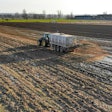
Integrating sensors into your feed mill allows you to capture, collect and monitor data that can be used to enhance production.
You have probably seen the terms internet of things, or IoT, and Industry 4.0 mentioned here and there throughout manufacturing. The concepts are not new. Many industries have already started to adapt the techniques; however, interest is starting to take hold within animal nutrition — and for good reason.
Industry 4.0 is not only a vision; it is a reality. There is a difference between developing big data and automatically processing big data. Industry 4.0 is utilizing various technologies at all levels of the plant and integrating the systems into a production plant control, thereby creating a Smart Factory, which seamlessly interconnects electro-mechanical sensors, electronics, software and humans.
IoT is the combination of several cyber-physical systems communicating with each other autonomously, thus generating an increased amount of data, and then using that data to improve operational excellence, usually measured with improvements to safety, quality, delivery and cost (SQDC).
To quote one of the great innovative thinkers of our time, Bill Gates: “The advance of technology is based on making it fit in so that you don’t really even notice it, so it’s part of everyday life.”
To implement IoT, you must connect every layer of your feed mill, starting at the plant floor level using sensors, devices that can convert a physical stimulus into measurable outputs, on equipment that monitor and control the process.
IoT basics
These sensors bring signals into the control system programmable logic controller (PLC) to provide inputs, so the computer-controlled process understands how to respond and operate. Adding another layer of supervisory control and data acquisition (SCADA) with networked data communication enables high-level process management. The layer after that is implementing a manufacturing execution system (MES). MES is a software that manages the data to track and document the transformation of raw materials to finished goods.
MES can also have functionality around traceability, inventory use, quality and preventative maintenance. The data generated and managed within MES is further connected through interfaces to your enterprise resource planning (ERP) system to connect the scheduling, labor, material and financial aspects of the business. To make IoT work, however, it has to start on the plant floor with sensors.
Various sensor types are available, and connecting sensors to existing machines to collect and measure the necessary information is relatively easy. The integration of sensors into control systems has increased the ability to capture, categorize and analyze data in a centralized location.
Feed mill applications
Sensors are used throughout the entire feed mill for control and data gathering, but we will focus on two examples: batching and pelleting.
Throughout the batching process, sensors are used to control and maintain quality and throughput, starting with bin low switches to indicate when a material may be running low, enabling automatic switchover to keep the process going. Over the past several years, there has been an expansion in the use of microingredient systems that utilize variable frequency drives (VFD) and multi-channel scale meters to improve the quality of the batching and throughput by eliminating hand-add processes that relied on operators. Tracking and trending the measurements of these systems over time provides useful data for ongoing quality control as well as indication of worn-out components.
Quality data on production lots can be brought in from the MES and overlaid with production data and process parameters to better understand and adjust the process to reduce variation and improve quality.
Pelleting is another great example of sensors providing multiple inputs to control the process. In addition to the bin sensors keeping material available to the continuous process, steam control valves provide signals to control the amount of steam entering the conditioner. Temperature transmitters then provide actual temperatures at the output of the conditioner to be used in the algorithm of the PID (proportional-integral-derivative) controller to make fine adjustments to keep the process on target. Various flow meters are used to accurately proportion liquids to the pelleting process with sensors that are able to manage changes in density of certain ingredients with temperature compensation.
All this enables feed mills to automatically pellet at higher rates and better quality. For years, people have been able to schedule preventative maintenance using simple hour meters, now by using production data from the MES in conjunction with the process data form the SCADA, preventative maintenance schedules can be driven by things like the tons of product produced.
Data informs improvements
Added pressure on operations to make high-quality feed and with increased formulas is essential for feed mills to make informed data-based decisions in such a fast-paced operational environment. With today’s technology, checking your mill’s overall performance is a necessity.
An operational dashboard can also be used to gain real-time visibility and control across your manufacturing supply chain. High-level metrics will help you drill down to granular detail for better troubleshooting and longer-term continuous improvement work.
The amount of data a feed mill can produce is daunting. Tracing or charting data over time for key process control points enables the visibility to quickly recognize abnormal conditions. Once these abnormalities are identified, the system can automatically alert staff to quality issues so you can swiftly resolve and reduce scrap or rework. Additionally, this gives you the ability to understand where to focus your longer-term continuous improvement efforts.
Whether your function is in operations, quality, warehousing, accounting, or supply chain management, having the right types of information immediately available to drive educated decision-making is key.
Fortunately, sensors have become relatively inexpensive, making them a cost-effective improvement to your operation. In addition, the cost of computers, networking, and data storage have also decreased significantly over the past decade. The investment of creating and maintaining the infrastructure to create this real-time data cyber physical system is not cheap but will support real return on investment (ROI) in improvements to SQDC.
In summary, the cost to instrument your feed mill with useful sensors has reduced significantly over the past several years, enabling feed mill operators to begin the evolution of deploying the internet of things. Tying that data to your automation control system augmented with MES can lead to real improvements in operational excellence.

















